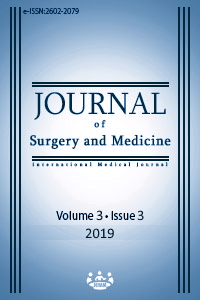Long-term outcomes of pure olive oil to prevent postoperative peritoneal adhesions in rats
Keywords:
Postoperative peritoneal adhesions, Olive oil, SurgeryAbstract
Aim: Postoperative peritoneal adhesion (PPA) that occur after abdominopelvic surgery are the current problems of surgeons. The aim of this study was to investigate the effect of pure olive oil in preventing PPA.
Methods: Thirty-two rats were randomly divided into four groups: (1) Sham group: 5 ml pure olive oil was injected percutaneously into the peritoneal cavity without laparotomy, (2) Adhesion group: A standard adhesion model was formed on jejunum, ileum and caecum. (3) Adhesion + olive oil: A standard adhesion model was formed on jejunum, ileum and caecum. Subsequently the area on jejunum, ileum and caecum was covered with 5 ml of pure olive oil. (4) Olive oil + adhesion: The area on jejunum, ileum and caecum was covered with 5 ml of pure olive oil. Subsequently the standard adhesion model was formed on this area. Four weeks later, abdominal cavities of rats were examined for PPA, using Evan’s adhesion classification and Zühlke’s histopathological grade scales.
Results: PPA was not found in Group 1 in which olive oil was injected intraperitoneally. PPA was present in all rats in Group 2. Microscopic adhesion scores in Group 3 and 4 were significantly lower than Group 2. The collagen fiber fractions were significantly lower and there was a significant decrease in fibrosis. There was no statistically significant difference in microscopic adhesion scores in Group 3 compared to Group 4.
Conclusion: We found that antiinflammation, tissue regeneration and hydroflotation effect of pure olive oil decreased PPA formation in rats by maintaining a long lasting effect on the wounded peritoneal surface. Thus olive oil, a cheap and easy to obtain product, can be used in cases of PPA in surgery clinics.
Downloads
References
Liakakos T, Thomakos N, Fine PM, Dervenis C, Young RL. Peritoneal adhesions: etiology, pathophysiology, and clinical significance. Recent advances in prevention and management. Dig Surg. 2001;18(4):260-73.
Menzies D. Postoperative adhesions: their treatment and relevance in clinical practice. Ann R Coll Surg Engl. 1993;75(3):147-53.
Tolu A, Gökçe Ö. Adezyonların Sebepleri ve Önlenmesi. T Klin Tıp Bilimleri. 1992;12(3):244-9.
Arnold PB, Green CW, Foresman PA, Rodeheaver GT. Evaluation of resorbable barriers for preventing surgical adhesions. Fertil Steril. 2000;73(1):157-61.
Kırdak T, Uysal E, Korun N. Karın içi yapışıklıkların önlenmesinde metilprednizolonun farklı dozlarının etkinliğinin incelenmesi. Ulus Travma Acil Cerrahi Derg. 2008;14(3):188-91.
Ryan GB, Grobety J, Majno G. Postoperative peritoneal adhesions. A study of the mechanisms. Am J Pathol. 1971;65(1):117-48.
Gomel V, Urman B, Gurgan T. Pathophysiology of adhesion formation and strategies for prevention. J Reprod Med. 1996;41(1):35-41.
Speroni E, Guerra MC, Minghetti A, Crespi-Perellino N, Pasini P, Piazza F, et.al. Oleuropein evaluated in vitro and in vivo as an antioxidant. Phytother. Res., 1998;12:98-100.
De la Puerta R, Martinez Dominguez E, Ruiz-Gutierrez V. Effect of minor components of virgin olive oil on topical antiinflammatory assays. Z Naturforsch. 2000;55:814-9.
Tranter HS, Tassou SC, Nychas GJ. The effect of the olive phenolic compound, oleuropein, on growth and enterotoxin B production by Staphylococcus aureus. J. Appl.Bacteriol. 1993;74:253-9.
Evans DM, McAree K, Guyton DP. Dose dependency and wound healing aspects of the use of tissue plasminogen activator in the prevention of intra-abdominal adhesions. Am J Surg. 1993;165(6):229-32.
Zühlke HV, Lorenz EM, Straub EM, Savvas V. Pathophysiology and classification of adhesions. Langenbecks Arch Chir Suppl II Verh Dtsch Ges Chir 1990:1009-16.
Audebert AJ, Gomel V. Role of microlaparoscopy in the diagnosis of peritoneal and visceral adhesions and in the prevention of bowel injury associated with blind trocar insertion. Fertil Steril. 2000;73(3):631-5.
Millamiemi H, Frolander M. The effect of glove powders and their constituents on adhesions and granuloma formation in the abdominal cavity of the rabbit. ACTA Chir Scand. 1966;131:312-8.
Blauer KL, Collins RL. The effect of intraperitoneal progesterone on postoperative adhesion formation in rabbit. Fertil Steril. 1988;49:144-9.
Drollette CM, Badawy SZA. Pathophysiology of pelvic adhesions: modern trends in preventing infertility. J Reprod Med. 1992;37:107-21.
Ryan G, Grobety J, Majino G. Postoperative peritoneal adhesions: a study of mechanism. Am J Pathol. 1971;65:117-48.
Demirel H, Altay K, Sultanoğlu E, Dolgun A, Odabaş Ö. Postoperatif İntraperitoneal Adezyonların Proflaksisinde Aprotinin, Dextran 7 Ve %1'luk Yağ Emülsiyonu ile Karşılaştırmalı Bir Çalışma. Türkiye Klinikleri Tıp Bilimleri Araştırma Degisi. 1990;8(6):524-8.
Tolu A, Gökçe Ö. Adezyonların Sebepleri ve Önlenmesi. T Klin Tıp Bilimleri. 1992;12(3):244-9.
Galili Y, Ben-Abraham R, Rabau M, Klausner J, Kluger Y. Reduction of surgery-induced peritoneal adhesions by methylene blue. Am J Surg. 1998;175(1):30-2.
De la Portilla F, Ynfante I, Bejarano D, Conde J, Fernandez A, Ortega JM, et al. Prevention of peritoneal adhesions by intraperitoneal administration of vitamin E: an experimental study in rats. Dis Colon Rectum. 2004;47(12):2157-61.
Dargenio R, Cimino C, Ragusa G, Garcea N, Stella C. Pharmacological prevention of postoperative adhesions experimentally induced in the rat. Acta Eur Fertil. 1986 Jul-Aug;17(4):267-72.
Özçelik A, Yurdakul İ. İntraabdominal Adezyonlar ve Önlenmesi. Veteriner Cerrahi Dergisi. 2006;12(1-4):62-7.
Holmdahl L, Eriksson E, Eriksson BI, Risberg B. Depression of peritoneal fibrinolysis during operation is a local response to trauma. Surgery. 1998;123(5):539-44.
Cicerale S, Lucas L, Keast R. Biological activities of phenolic compounds present in virgin olive oil. Int J Mol Sci. 2010 Feb 2;11(2):458-79.
Ellis H. The magnitude of adhesion-related problems. In: M.D. GSd, eds. Peritoneal Surgery. New York: Springer; 2000. pp. 297-306.
Baum C, Arpey C. Normal cutaneous wound healing: Clinical correlation with cellular and molecular events. Dermatol Surg. 2005;31(6):674-8661.
Downloads
- 1428 2136
Published
Issue
Section
How to Cite
License
Copyright (c) 2019 Dilan Altıntaş Ural, Haluk Saruhan, İsmail Saygın, Duygun Altıntaş Aykan, Alper Ural, Mustafa İmamoğlu
This work is licensed under a Creative Commons Attribution-NonCommercial-NoDerivatives 4.0 International License.
















